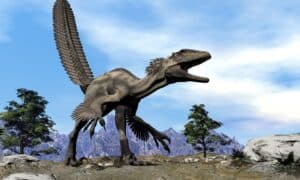Dinosaur names start with every letter of the alphabet, and dinosaurs that start with M are not rare. They lived in the prehistoric time periods, eras, and epochs when the dinosaurs ruled and lived all around the world, from countries that became Africa, North America, Australia, and beyond. Here are nine incredible dinosaurs that start with M.
1. Moschops

This dinosaur from the Permian period had legs that were more like a mammal’s legs than a reptile’s.
©YuRi Photolife/Shutterstock.com
Moschops, whose name means “calf face,” or “calf eye” in Greek was a type of therapsid. These dinosaurs were precursors of mammals and share traits such as leg position. Their legs were underneath their body instead of sprawled out as they are in reptiles. Moschops lived during the Permian period, about 265 to 260 million years ago. Its fossils were found in South Africa.
This dinosaur was nearly 9 feet long and could weigh between 284 to 722 pounds. Its head was small in proportion to its robust body, but it had a thick skull, large eye sockets, and powerful jaws. Its teeth, though quite strong, were those of an herbivore, and archaeologists believe that it ate tough plant material. Because the plants, probably cycads and other ancient plants, were nutrient poor, the animal probably had to eat for much of the day. Scientists believe that its thick skull was used in head butting competitions, and that Moschops spent at least some of its time in the water like a hippopotamus.
2. Minmi
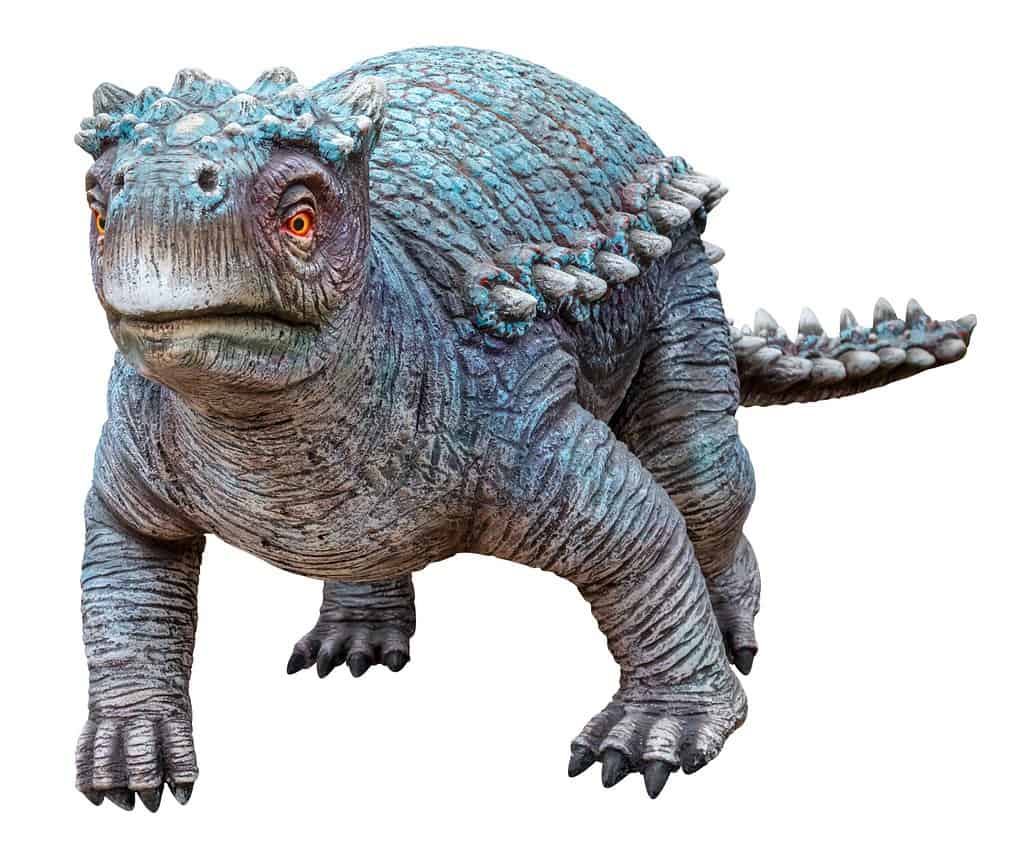
This relatively small herbivore gets its name from Minmi Crossing in Australia.
©YuRi Photolife/Shutterstock.com
Minmi paravertebra was a small herbivore that lived in what’s now Australia and whose fossils were found at Minmi Crossing. It was a type of ankylosaur, which means it was an armored quadruped. Minmi was different from other ankylosaurs in that it had backward-facing horizontal plates made of ossified tendons along its sides. It also lacked a bony club at the end of its tail and armor on its head, but its belly did have some armor. Its legs were also longer than the legs of other ankylosaurs, which probably allowed it to run fast enough to escape predators.
This dinosaur probably had triangle shaped, serrated teeth, a long tongue and a secondary palate that let it breathe as it ate. It probably ate ancient vegetation such as seeds, flowering plants, and ferns. Minmi was about 9.84 feet long and lived 121 to 112 million years ago during the Early Cretaceous period.
3. Megalosaurus
“Megalo” is Greek for “big”, and this dinosaur fit the bill. It was a carnivore that lived about 166 million years ago during the Middle Jurassic epoch. The first fossil was identified in 1824, and a model of it was made for the Crystal Palace exhibit in 1854. Like the other dinosaur sculptures, Megalosaurus was put together entirely the wrong way. Even now, archaeologists aren’t completely sure what the animal looked like as a complete skeleton has yet to be found.
What scientists do know about this dinosaur is that it was about 20 feet long, bipedal though with a horizontal stance and weighed about 1,500 pounds. It had powerful back legs with three toes. Its “arms” were short but strong and had three clawed fingers. It also had a big head filled with large, curved teeth like daggers.
4. Machairoceratops
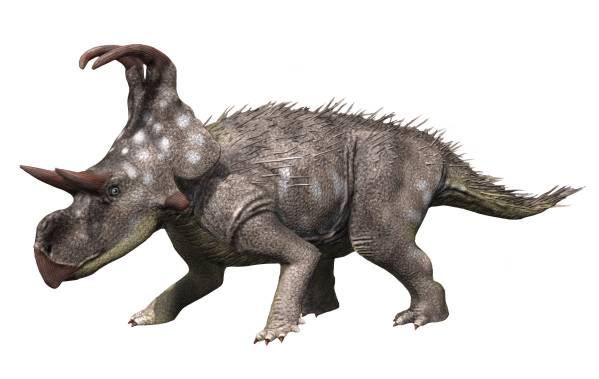
The species name of
Machairoceratops cronusicomes from the Greek god Cronus.
The tongue-twisting name of this dinosaur means “bent sword horned face,” and the genus has only one species, M. cronusi. The specific name actually honors Cronus, a Greek Titan who castrated his own father with a scythe. The scythe perhaps reminded archaeologists of Machairoceratops’ facial horns.
This dinosaur lived in the Late Cretaceous period, which was about 81 to 77 million years ago. Though a complete skeleton hasn’t been unearthed, enough of the dinosaur’s head has been found in Utah to give scientists a picture of what it looked like in real life.
Machairoceratops was probably 20 to 26 feet long and weighed in at one to two tons.
5. Magnapaulia

Magnapaulia was a species of hadrosaur.
©Noiel/Shutterstock.com
The fossils of this huge hadrosaur were first found in Baja California. It lived during the Late Cretaceous period, about 74.7 million years ago. This animal was between 49.2 and 54.1 feet long and could have weighed as much as 8.8 tons. Archaeologists were especially interested in its tail, which had long chevrons and spines that grew out of the caudal vertebrae. Another amazing thing about this dinosaur is that impressions of its skin fossilized, and the tail of one individual was seen to have a pattern of round and six-sided scales.
So far, the one species of this dinosaur is M. laticaudus, which means “broad tail.” Magnapaulia is one of the Lambeosaurines, a subfamily in the Hadrosauridae family. These dinosaurs are known as duck-billed hadrosaurs because their snouts have the appearance of duck bills. They were herbivores, and their teeth formed dental batteries to help grind the tough plant material that they ate.
6. Monoclonius
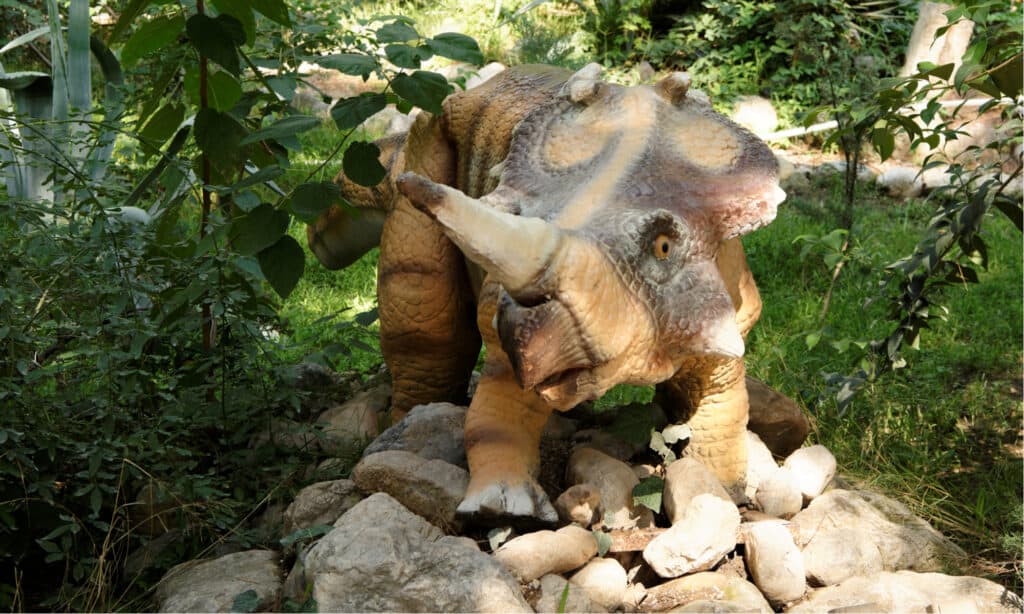
A ceratopsid dinosaur, Monoclonius lived in what is now Canada.
©Aleks49/Shutterstock.com
Like Machairoceratops, Monoclonius was a ceratopsid that lived in what’s now Montana and Alberta Canada in the Late Cretaceous period, about 75 to 74.6 million years ago. Scientists have found only scattered pieces of fossilized skeleton, almost certainly from different individuals. Monoclonius has been confused with other dinosaurs such as Centrosaurus. Because of this, the Monoclonius genus is considered a “doubtful name” or nomen dubium.
Scientists believe that Monoclonius was a quadruped and could have been 16.5 feet long. Its head alone was about 6 feet in length. Like other ceratopsid dinosaurs, it had a frill over its neck. It had a single rhinoceros-like horn on its nose, two horns over each eye, and a parrot-like beak. Despite this, the dinosaur had many teeth and used them to chew tough plants like cycads. Though Monoclonius means “single sprout” in Greek, it doesn’t refer to the dinosaur’s horn but its tooth.
Some archaeologists believe that Monoclonius traveled in herds and that the frills of males were showier than those of females and used during courtship. The type species is M. crassus. Crassus means “fat one.”
7. Microraptor

One of the smallest dinosaurs that start with M, microraptor had four wings!
©iStock.com/MR1805
These little dinosaurs could not only fly, but they had two pairs of wings. Fossils were found in China, and it’s believed they’re from the early Cretaceous period, which was about 125 to 120 million years ago. Unlike some other dinosaurs, there are many fossilized skeletons of Microraptor. They’re not only the smallest of the dinosaurs that didn’t evolve into birds, but they’re the first where archaeologists saw the impressions of the animal’s feathers in its fossils. There are three Microraptor species:
- M. zhaoianus
- M. guiu
- M. hanqingi
Microraptor not only had feathers on its wings but on its legs and the end of its tail as well. As with birds, the tail feathers gave stability while the animal flew. Not only this, but archaeologists also know what color the dinosaur’s feathers were. They appeared to have been iridescent black.
One of the smallest of the dinosaurs that start with M, Microraptor was tiny, only around 2.53 feet long with a 2.89-to-3.08-foot wingspan. It only weighed between one and three pounds. There were larger individuals, but they weren’t much larger. The dinosaur was also carnivorous, as scientists found remains of mammals, birds, small reptiles, and fish inside its gut.
8. Mamenchisauris
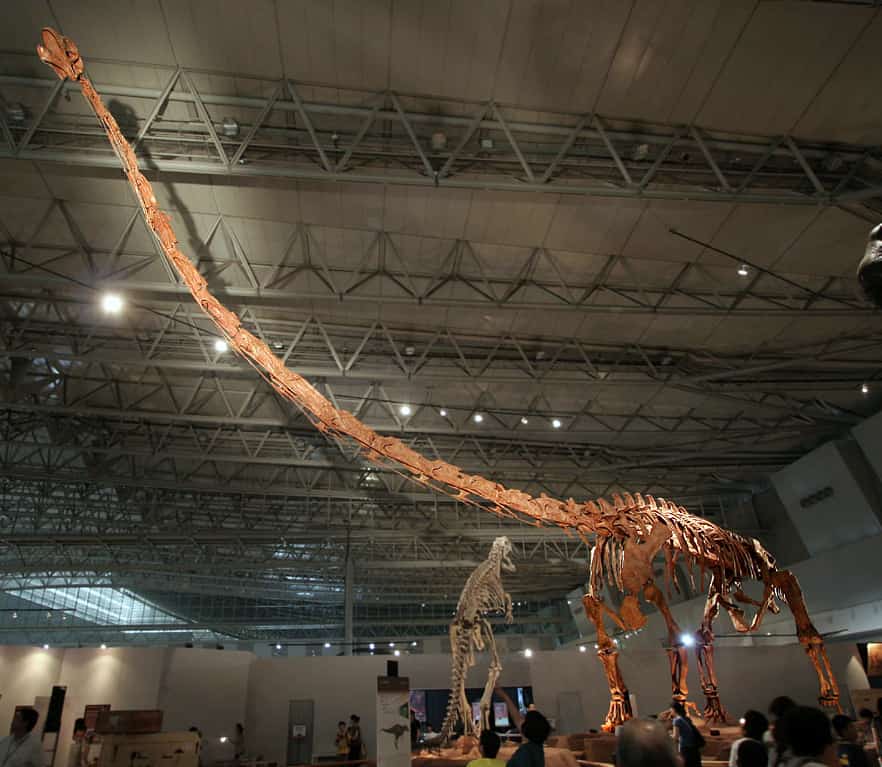
This recreation shows the dinosaur’s incredibly long neck, reinforced by bony struts.
Of all the dinosaurs that start with M, this huge sauropod dinosaur is known for its nearly freakishly long neck. Its neck was nearly half the length of its entire body. Scientists have discovered a few species of this dinosaur, who lived between 161 and 114 million years ago, in China.
The type species of this dinosaur is M. constructus, whose fossils were dug up from a construction site in China’s Sichuan Province in 1952. The other species are:
- M. hochuanensis
- M. sinocanadorum
- M. youngi
- M. anyuensis
- M. jingyanensis
Mamenchisaurus was about 72 feet long though some archaeologists suspect individuals could be much longer based on the size of a vertebra. The animal could weigh as much as 20 tons. The neck could be as long as 31 feet, had 19 vertebrae, and was reinforced by overlapping struts. This also made the neck stiff, and it was probably held nearly horizontally as the animal walked. However, the long neck gave this beast an advantage over other long necked dinosaurs, for when it reared up on its massive hind legs it was able to reach the young leaves at the very top of tall trees. The tail, reinforced by chevron shaped bones, stabilized the animal, and the position of the pelvis might have meant that Mamenchisaurus could even walk on two legs for short periods.
9. Maiasaura
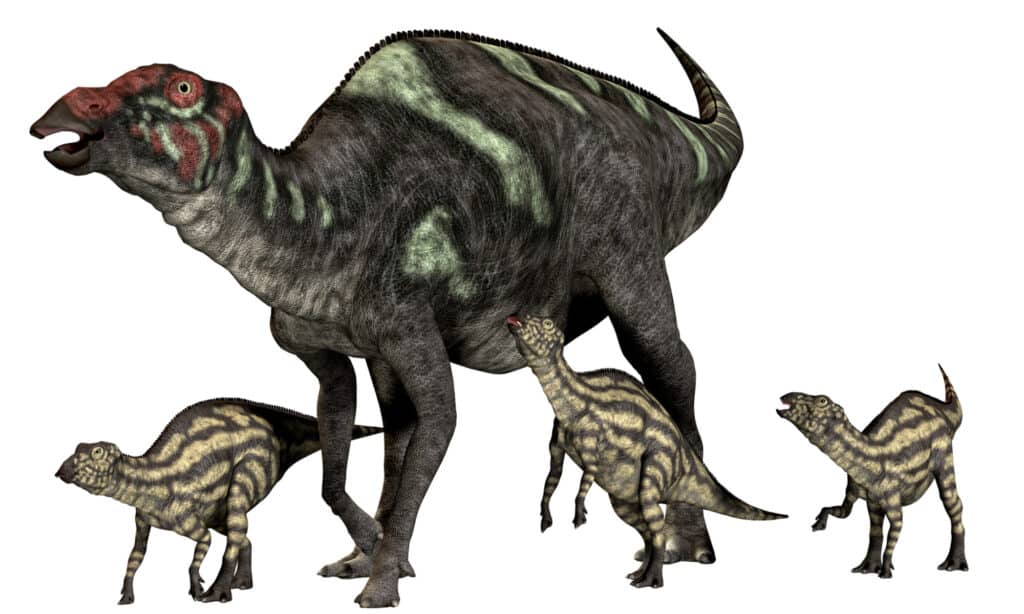
Another of the dinosaurs that start with M, Maiasaura’s name means “good mother reptile” in Greek.
©Catmando/Shutterstock.com
This hadrosaur was one of the few dinosaurs whose genus name ended with the female version of the Greek word for reptile, which is “saura.” That’s because it was deemed to be a good mother, as it fed its babies while they were still in the nest. Like Monoclonius, Maiasaura lived in Alberta, Canada and Montana, though its heyday was a little earlier, about 76 million years ago.
A grown Maiasaur was about 30 feet long, weighed as much as 4.4 tons and usually walked on all fours, though babies were bipedal. It had the “duck bill” of other hadrosaurs and a crest in front of the eyes that scientists believed were used by males in head butting contests. One sex was notably larger than the other, but scientists don’t know if it was the male or the female.
How Maiasaura Raised Its Babies
Archaeologists know that Maiasaurs lived in great herds and nested in colonies. Their earthen nests were about 23 feet around and the eggs were laid in a concentric circles or spirals. There were between 30 to 40 eggs in a nest, and they were about as large as ostrich eggs. Though that’s large by modern standards the eggs were probably too fragile for a four-ton parent to sit on, so parents covered them with decomposing vegetation to keep them warm. After they hatched the parent had to bring the babies food, for their legs were underdeveloped. Still, most Maiasaura babies died before they were a year old. Maiasaurs were fully grown when they were about eight years old.
Maiasaurs were herbivores, and they not only ate leaves and plants such as ferns, but they ate wood and bark, even if it was rotting. This is probably because the area where they lived was subject to long droughts.
Thank you for reading! Have some feedback for us? Contact the AZ Animals editorial team.








